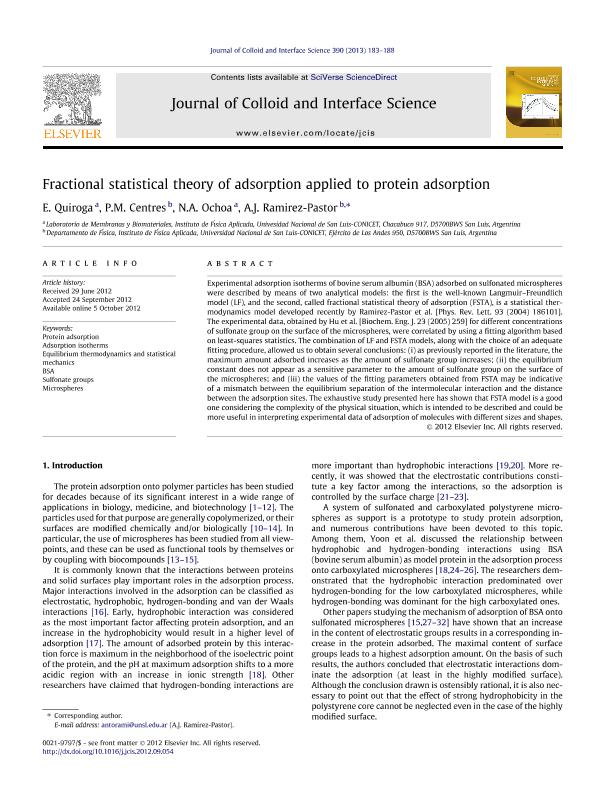Artículo
Fractional Statistical Theory of Adsorption Applied to Protein Adsorption
Fecha de publicación:
01/2013
Editorial:
Elsevier
Revista:
Journal of Colloid and Interface Science
ISSN:
0021-9797
Idioma:
Inglés
Tipo de recurso:
Artículo publicado
Clasificación temática:
Resumen
Experimental adsorption isotherms of bovine serum albumin (BSA) adsorbed on sulfonated microspheres were described by means of two analytical models: the first is the well-known Langmuir–Freundlich model (LF), and the second, called fractional statistical theory of adsorption (FSTA), is a statistical thermodynamics model developed recently by Ramirez-Pastor et al. [Phys. Rev. Lett. 93 (2004) 186101]. The experimental data, obtained by Hu et al. [Biochem. Eng. J. 23 (2005) 259] for different concentrations of sulfonate group on the surface of the microspheres, were correlated by using a fitting algorithm based on least-squares statistics. The combination of LF and FSTA models, along with the choice of an adequate fitting procedure, allowed us to obtain several conclusions: (i) as previously reported in the literature, the maximum amount adsorbed increases as the amount of sulfonate group increases; (ii) the equilibrium constant does not appear as a sensitive parameter to the amount of sulfonate group on the surface of the microspheres; and (iii) the values of the fitting parameters obtained from FSTA may be indicative of a mismatch between the equilibrium separation of the intermolecular interaction and the distance between the adsorption sites. The exhaustive study presented here has shown that FSTA model is a good one considering the complexity of the physical situation, which is intended to be described and could be more useful in interpreting experimental data of adsorption of molecules with different sizes and shapes.
Archivos asociados
Licencia
Identificadores
Colecciones
Articulos(INFAP)
Articulos de INST. DE FISICA APLICADA "DR. JORGE ANDRES ZGRABLICH"
Articulos de INST. DE FISICA APLICADA "DR. JORGE ANDRES ZGRABLICH"
Citación
Quiroga, Evelina; Ramirez Pastor, Antonio Jose; Ochoa, Nelio Ariel; Centres, Paulo Marcelo; Fractional Statistical Theory of Adsorption Applied to Protein Adsorption; Elsevier; Journal of Colloid and Interface Science; 390; 1; 1-2013; 183-188
Compartir
Altmétricas




